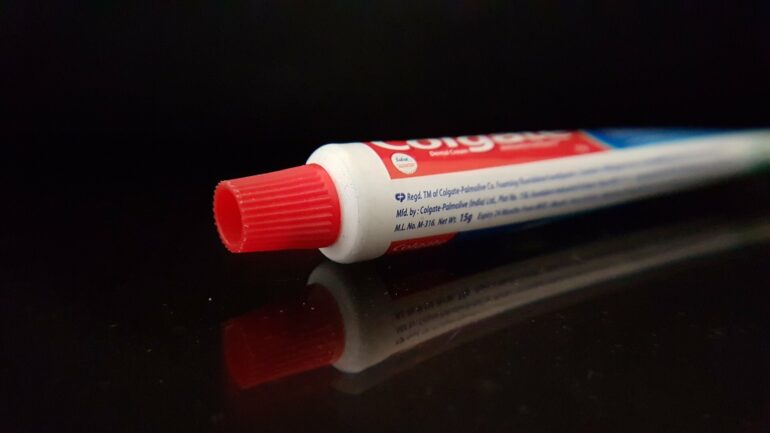Imagine you’re browsing the toothpaste aisle and see next to Colgate a new brand called Colddate, packaged in a box with similar colors and designs. “You might think this is clearly a copycat brand,” said Ming Hsu, William Halford Jr. Family Chair in Marketing at the Haas School of Business, UC Berkeley.
Yet in a real-life trademark infringement case involving these two brands, Colgate-Palmolive lost the suit, with the judge saying they were “similar” but not “substantially indistinguishable.”
There are often different opinions between judges and juries in trademark cases about how similar the brands in question actually are, leading to large inconsistencies in the application of the law. In a paper published February 8 in the journal Science Advances, Hsu and colleagues propose a more scientific measure through the use of brain scans—employing functional magnetic resonance imaging (fMRI) along with a specialized technique called repetition suppression (RS).
“Asking the brain, not a person, could reduce—if not eliminate—these inconsistencies,” said lead author Zhihao Zhang, a former Berkeley Haas postdoctoral researcher now on the faculty of the Darden School of Business, University of Virginia. The study’s other authors include Dr. Andrew Kayser of UC San Francisco, Femke van Horen of Vrije University Amsterdam, and Mark Bartholomew of University at Buffalo Law School.
What is “similarity”?
The standard according to the law is whether a “reasonable person” would find two trademarks similar, but it doesn’t define what similar means.
“Similarity is an incredibly hard thing to measure in an objective way,” said Zhang. “Making things worse, in the adversarial legal system, two opposing parties each hire their own attorneys and expert witnesses who present their own evidence.”
Often that evidence takes the form of consumer surveys, which have been shown to be susceptible to manipulation—for example, through the use of leading questions. Not surprisingly, plaintiffs are known to present surveys finding that the two trademarks are similar, while defendants present competing surveys showing they are different.
“There is no gold standard in the law about what background information survey respondents receive, how the questions are phrased, and what criteria of ‘similarity’ should be followed— all factors that can change the results substantially,” Zhang said. “Judges have a lot of experience with these situations, and have developed some degree of cynicism.”
Oftentimes, Hsu added, judges just say, ‘I don’t believe any of you, I’m going to go with my own gut.’ It’s easy to sympathize with these judges, who just throw up their hands.”
Putting brains on the witness stand
In their paper, the researchers demonstrated how looking directly into the brain may help solve this conundrum. They put participants in fMRI scanners, and rapidly showed them pairs of images consisting of the main brand and a supposed copycat. Previous research has consistently shown that when presented with two similar images, the brain suppresses activity for the second image, perhaps out of efficiency, thinking it’s already seen the image. By measuring the amount of repetition suppression (RS) in brain activity for the second image, the researchers determined how similar a person found the two images.
The resulting approach provides an important benefit: Participants are blind to the goal of the study, which further reduces bias. “This is because we don’t have to ask them any questions at all or tell them what it means to be similar or not,” said Hsu.
“In fact, even the experimenter administering the study doesn’t need to know its purpose, which makes it a ‘double-blind’ study like the rigorous clinical studies in drug development,” added Kayser.
Indeed, when the research team checked the results of the neuroimaging against survey results that are intended to be pro-plaintiff, pro-defendant, or neutral, they found the brain-based measure can reliably pick out the more neutral survey results, supporting the idea that the brain scans can improve the quality of legal evidence in these cases.
This kind of evidence could be provided as a supplemental “spot check” to survey evidence, giving a judge or jury confidence the surveys are accurate, Hsu said. The cost of using neuroimaging is comparable to presenting survey data, the researchers said.
Scientists provide the ruler, courts draw the line
Importantly, the brain-based measures don’t take away the need for judgment by the court. “Our method still doesn’t say how similar is too similar,” said Kayser. “Our job as scientists is to provide a better ruler. It’s still up to the judge to decide where to draw the line.”
More broadly, introducing new techniques like this will require more discussion between disciplines and a better understanding by legal practitioners of what value these techniques deliver, said Bartholomew, who served as the legal expert on the research team. “Courts have an important role in deciding when new kinds of scientific insights should be allowed in to potentially influence the outcome of a case,” he said. “This gatekeeping role means that both judges and the lawyers appearing before them increasingly need to have a working knowledge of neuroscientific techniques.”
While this study only looked at visual trademark cases, the researchers say this kind of neural measure holds promise for a wide range of legal applications revolving around people’s mental reactions—for example, determining copyright infringement in music cases, or determining how a “reasonable person” would judge obscenity, negligence, or other legal issues.
“It’s striking how often people’s opinions matter in the courts, and how often this standard of a ‘reasonable person’ is applied in the law,” Hsu said. “While we are not there yet, one can imagine a future where we ask the brain to help us answer these difficult questions.”
More information:
From Scanner to Court: A Neuroscientifically Informed “Reasonable Person” 5 Test of Trademark Infringement, Science Advances (2023).
Provided by
University of California – Berkeley
Citation:
New approach puts brain scans on the witness stand in trademark disputes (2023, February 8)


